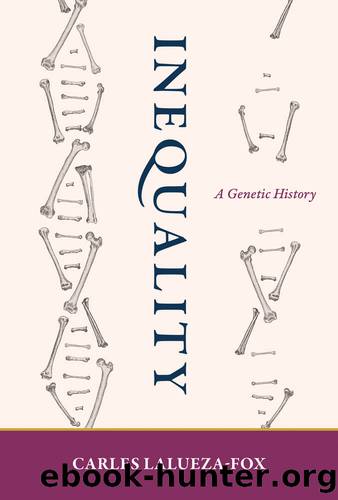Inequality by Carles Lalueza-Fox

Author:Carles Lalueza-Fox [Lalueza-Fox, Carles]
Language: eng
Format: epub
Publisher: MIT Press
Figure 4.3
Percentage of same-caste marriages in different Indian states at the start of the twenty-first century. The persistence of the caste system is regionally structured, with a partial reversal in the regions with a higher incidence of tribal groups that are outside the system. Notice that in vast regions, intercaste marriages are less than 10 percent of the total marriages. Source: National Family Health Survey, NFHS-III, 2005â2006, government of India.
The pre-Columbian Americas were also the stage for specific, autochthonous social structures that can be studied via ancient genetics. Spanish colonial chronicles explain that central Andean populations, notably Quechuas and Aymaras, corresponding to present-day Peru, Ecuador, and Bolivia, practiced a unique social model called ayllu (literally, âfamily clanâ or âenlarged communityâ). Within-group (or ayllu) unions were preferred over between-group ones; this system of close-kin marriages (or endogamy) created a lack of genetic diversity within ayllu somewhat similar to that observed in Indian castes. One way to look for signs of this norm is by searching for stretches of the individualsâ genome where both chromosomal copiesâone from each parentâare identical (the longer the chromosomal section, the more recent a common ancestor of the parents would be). The presence of these sections is therefore indicative of recent population history and social marriage practices; a large population where mating is closer to random will be devoid of such genetic signs in its genomes. By analyzing forty-six ancient Andean individuals, researchers could detect that after 1000 CE, and prior to the arrival of the Spaniards, the rate of family-related unions underwent a substantial increase, from 9 to 46 percent.43 This trend coincides with the decline of some widespread archaeological horizons in the Central Andes, which led to a transition to fragmented sociopolitical unities primarily defined by shared ancestry. This shift in turn intensified episodes of intergroup violence prior to the arrival of the Incas, who maintained the ayllu system as a fundamental social element in their empire.
It is interesting to consider that social systems such as the Indian castes and the ayllu may have similar genetic consequences as those observed in small, isolated populations (due either to geography, as on small islands, or religious reasons, such as the Amish) along with the resulting loss of genetic diversity due to endogamy. Thus although populations in caste India and pre-Columbian South America were demographically large, the genetic diversity resulting from their social structure would be smaller than expected from their numbers alone. As Reich explains, the India of 1.3 billion people would be, from a genetic point of view, the equivalent of a large number of small populations. The same effect has been recently described in British Pakistanis, in whom genetic studies have demonstrated extensive endogamy patterns for the last seventy generations or so (that is, as far back as fifteen hundred to two thousand years ago, coinciding with the likely origin of Indian castes), with some major bottlenecks in the last five hundred years, perhaps coinciding with Islamization.44 In addition, this genetic pattern is associated with
Download
This site does not store any files on its server. We only index and link to content provided by other sites. Please contact the content providers to delete copyright contents if any and email us, we'll remove relevant links or contents immediately.
Lifespan: Why We Age—and Why We Don't Have To by David A. Sinclair & Matthew D. LaPlante(769)
The Environmental and Genetic Causes of Autism [2016] by James Lyons-Weiler(766)
Blueprint by Robert Plomin(747)
Emperor of All Maladies A Biography of Cancer, The(718)
Genetics by Unknown(683)
The Mansion of Happiness by Jill Lepore(613)
Mercies in Disguise by Gina Kolata(611)
Britain's DNA Journey by Alistair Moffat(607)
Introducing Genetics (Introducing...) by Steve Jones(603)
The Lost Family by Libby Copeland(583)
Gene Cloning and DNA Analysis by Brown T. A.;(572)
The New Eugenics by Judith Daar(549)
Medical Genetics by G. Bradley Schaefer(501)
Eugenics and Other Evils by G. K. Chesterton(499)
Junk DNA by Carey Nessa(483)
The Compatibility Gene by Davis Daniel M(470)
The Murder of Nikolai Vavilov by Peter Pringle(442)
The Genetic Strand by Edward Ball(437)
Essential Genetics and Genomics by Hartl Daniel L.;(430)
